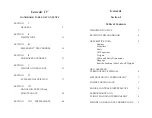
Section III
Table
of Contents
EMERGENCY
AIRSPEEDS
17
ENGINE
FAILURE
17
ROUGH RUNNING ENGINE
19
ENGINE
FIRE 19
EMERGENCY
DESCENT
19
MAXIMUM GLIDE CONFIGURATION
20
LANDING
EMERGENCIES
20
SYSTEMS
EMERGENCIES
20
Propeller Overspeed
Propeller Damage
Electrical System Failure
Speed Brakes
Landing Gear
UNLATCHED DOOR IN FLIGHT
22
SPINS
22
EMERGENCY SPEED REDUCTION
22
NOTE
All airspeeds quoted in this section are indi-
cated airspeeds (KIAS) and assume zero instrument
error. Each aircraft should be calibrated to deter-
mine its specific error for various configurations.
A Pacer
method is suggested, flying against a
“known” aircraft
.
EMERGENCY AIRSPEEDS
Emergency Descent (Idle Power, Gear/Flaps up
170-274
Best
Glide
120
Landing Approach (W/O Power)
110
NOTE
The following check-lists are presented to
capture in a compact format those pilot tasks requir-
ing rapid action. These checklists should be kept
handy for ready access by the pilot, and he should
familiarize him/herself with them before flying the
aircraft. Knowledge of the switches, control, gauge,
etc. location quickly, even blindfolded, is highly
desirable. “Cockpit time” prior to ever flying or
after an absence is time prudently spent. Where
more time would be likely available, rationale will
be added and alternative choices offered. It must
be remembered however that each situation will be
unique in some manner and must be treated as such.
ENGINE FAILURE.
Engine power loss during takeoff (not airborne)
















































